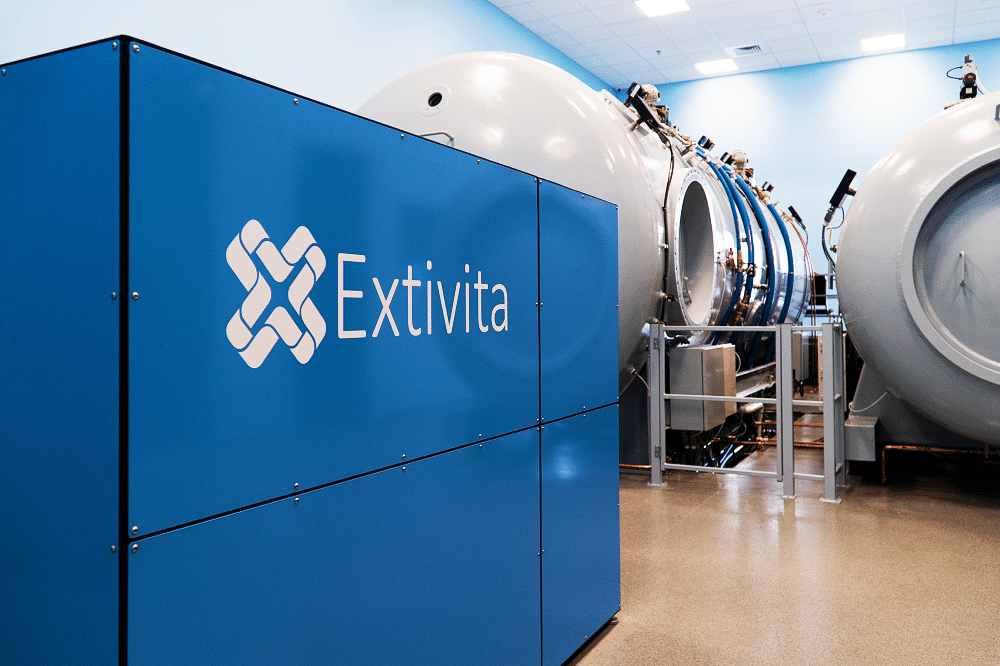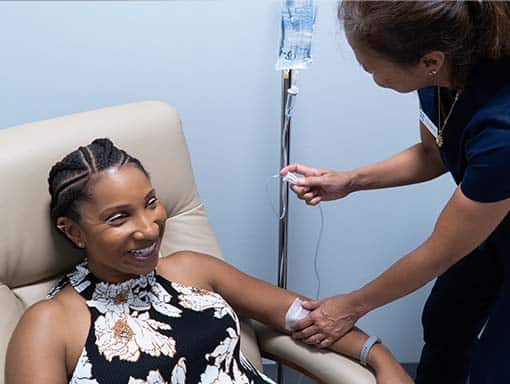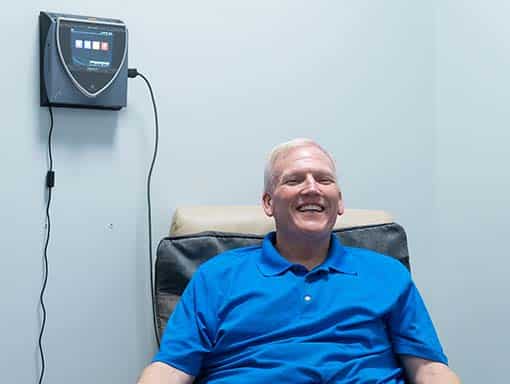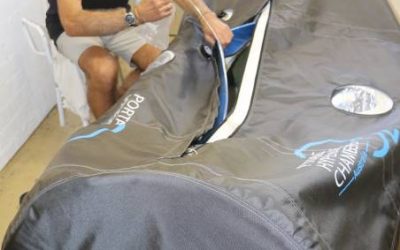Parkinson’s Disease
Parkinson’s Disease (PD) is a neurogenerative disease characterized by severe motor and non-motor symptoms(1). The prevalence of PD in the United States is growing but is currently estimated to be 572 per 100,000 with the risk of PD increasing with age(2, 3).
The root cause of PD is believed to involve genetic and environmental factors, toxin exposure, oxidative stress, neuroinflammation, hypoxia, metabolic dysfunction, and ubiquitin–proteasome system dysfunction. The outcome is clusters of misfolded proteins called Lewy bodies that cause serious damage to brain cells, especially dopamine-producing neurons in the substantia nigra (SN) that project to the striatum(4).
This damage is likely the cause of the severe motor symptoms (slow movement, muscle rigidity, tremors, posture problems) and non-motor symptoms (cognitive dysfunction, sleep issues, fatigue) that are characteristic of PD(5, 6). The combination of these symptoms significantly decreases quality of life, especially the categories of physical function and mental health(7).
Extivita Therapies for Parkinson’s Disease:
Extivita Therapies for Parkinson’s Disease:

Hyperbaric Oxygen Therapy

Infrared Sauna

Supplements

Nutritional IV Therapy

Pulsed Electromagnetic Field Therapy
Hyperbaric Oxygen Therapy for Parkinson’s Disease:

Hyperbaric oxygen therapy (HBOT) may be beneficial for those with Parkinson’s Disease (PD) due to its ability to reduce oxidative stress, decrease neuroinflammation, and improve mitochondrial function(8-10).
In people with PD, oxidative stress contributes to the degeneration of dopamine-producing neurons in the substantia nigra (SN)(11). The SN is the part of the brain involved in physical movement, so degeneration of these neurons can cause physical symptoms like tremors, slow movements, muscle stiffness and loss of automatic movements. HBOT is known to decrease oxidative stress, which may help relieve neuronal damage and the resulting physical symptoms(8).
Oxidative stress also leads to dysregulation of the inflammatory response, which is associated with the onset and progression of neurodegenerative diseases such as PD(9). HBOT upregulates defense mechanisms that help decrease neuroinflammation, therefore it may aid in reducing risk of PD disease progression(8). HBOT also improves mitochondrial function, something which is believed to be damaged in those with PD(4, 10).
Effects of HBOT on Parkinson’s Disease:

New Blood Vessel Formation

Increased Stem Cell Activity

Decreased Inflammation
IV Therapy for Parkinson’s Disease:
We highly recommend our glutathione (GSH) IV due to the GSH deficiency that has been observed in Parkinson’s Disease (PD)(12-13). This deficiency is present in the substantia nigra of patients with PD, and the level of deficiency appears to be correlated with disease severity(16).
GSH is the body’s master antioxidant. It directly protects your cells from the oxidative stress that causes cellular damage in the SN. Without appropriate levels of GSH, your cells are at an increased risk of damage from free radicals and oxidative stress. Thankfully, studies have shown that replenishing intracellular GSH levels can prevent oxidative damage and maintain mitochondrial function in dopaminergic cells, which are the main cells damaged in PD(14). While GSH IV treatment cannot prevent the occurrence of symptoms, it significantly slows down the occurrence of symptoms and improves existing symptoms(15-16).


Pulsed Electromagnetic Field Therapy for Parkinson’s Disease:
We recommend pulsed electromagnetic field (PEMF) therapy due to its supportive healing effects for those with Parkinson’s Disease (PD). PEMF therapy has been shown to reduce inflammation and oxidative stress, two key contributors to PD pathogenesis(17-21). Since PEMF therapy is incredibly low-risk, non-invasive, and relatively quick (sessions last 20 minutes at the most), we recommend it to nearly all patients receiving care for PD at Extivita.
News & Research for Parkinson’s Disease:
Hyperbaric oxygen therapy the latest in Lee Anlezark’s Parkinson’s fight
After receiving a Parkinson's Disease diagnosis in 2005, at the age of 49, Lee Anlezark is using hyperbaric oxygen therapy (HBOT) as a means to slow down the progression of the disease. Mr. Anlezark was so passionate in his beliefs that HBOT could help him, he paid...
References
- Sveinbjornsdottir, Sigurlaug. “The Clinical Symptoms of Parkinson’s Disease.” Journal of Neurochemistry, vol. 139, no. S1, 2016, pp. 318–24. Wiley Online Library, doi:10.1111/jnc.13691.
- Marras, C., et al. “Prevalence of Parkinson’s Disease across North America.” Npj Parkinson’s Disease, vol. 4, no. 1, July 2018, pp. 1–7. www.nature.com, doi:10.1038/s41531-018-0058-0.
- Pringsheim, Tamara, et al. “The Prevalence of Parkinson’s Disease: A Systematic Review and Meta-Analysis.” Movement Disorders: Official Journal of the Movement Disorder Society, vol. 29, no. 13, Nov. 2014, pp. 1583–90. PubMed, doi:10.1002/mds.25945.
- Cacabelos, Ramón. “Parkinson’s Disease: From Pathogenesis to Pharmacogenomics.” International Journal of Molecular Sciences, vol. 18, no. 3, Mar. 2017, p. 551. PubMed Central, doi:10.3390/ijms18030551.
- Schrag, Anette, et al. “Prediagnostic Presentations of Parkinson’s Disease in Primary Care: A Case-Control Study.” The Lancet. Neurology, vol. 14, no. 1, Jan. 2015, pp. 57–64. PubMed, doi:10.1016/S1474-4422(14)70287-X.
- Hughes, A. J., et al. “Accuracy of Clinical Diagnosis of Idiopathic Parkinson’s Disease: A Clinico-Pathological Study of 100 Cases.” Journal of Neurology, Neurosurgery, and Psychiatry, vol. 55, no. 3, Mar. 1992, pp. 181–84. PubMed, doi:10.1136/jnnp.55.3.181.
- Zhao, Na, et al. “Quality of Life in Parkinson’s Disease: A Systematic Review and Meta-Analysis of Comparative Studies.” CNS Neuroscience & Therapeutics, vol. 27, no. 3, 2021, pp. 270–79. Wiley Online Library, doi:10.1111/cns.13549.
- Thom, Stephen R. “Oxidative stress is fundamental to hyperbaric oxygen therapy.” Journal of applied physiology (Bethesda, Md. : 1985) vol. 106,3 (2009): 988-95. doi:10.1152/japplphysiol.91004.2008
- Solleiro-Villavicencio, Helena, and Selva Rivas-Arancibia. “Effect of Chronic Oxidative Stress on Neuroinflammatory Response Mediated by CD4+T Cells in Neurodegenerative Diseases.” Frontiers in cellular neuroscience vol. 12 114. 27 Apr. 2018, doi:10.3389/fncel.2018.00114
- Przedborski, Serge. “Inflammation and Parkinson’s disease pathogenesis.” Movement disorders : official journal of the Movement Disorder Society vol. 25 Suppl 1 (2010): S55-7. doi:10.1002/mds.22638
- Dias, Vera et al. “The role of oxidative stress in Parkinson’s disease.” Journal of Parkinson’s disease vol. 3,4 (2013): 461-91. doi:10.3233/JPD-130230
- Sofic, E., et al. “Reduced and Oxidized Glutathione in the Substantia Nigra of Patients with Parkinson’s Disease.” Neuroscience Letters, vol. 142, no. 2, Aug. 1992, pp. 128–30. ScienceDirect, https://doi.org/10.1016/0304-3940(92)90355-B.
- Sian, Jeswinder, et al. “Alterations in Glutathione Levels in Parkinson’s Disease and Other Neurodegenerative Disorders Affecting Basal Ganglia.” Annals of Neurology, vol. 36, no. 3, 1994, pp. 348–55. Wiley Online Library, https://doi.org/10.1002/ana.410360305.
- Aaseth, Jan et al. “Prevention of progression in Parkinson’s disease.” Biometals : an international journal on the role of metal ions in biology, biochemistry, and medicine vol. 31,5 (2018): 737-747. doi:10.1007/s10534-018-0131-5
- Sechi, G et al. “Reduced intravenous glutathione in the treatment of early Parkinson’s disease.” Progress in neuro-psychopharmacology & biological psychiatry vol. 20,7 (1996): 1159-70. doi:10.1016/s0278-5846(96)00103-0
- Duarte-Jurado, Ana Patricia et al. “Antioxidant Therapeutics in Parkinson’s Disease: Current Challenges and Opportunities.” Antioxidants (Basel, Switzerland) vol. 10,3 453. 15 Mar. 2021, doi:10.3390/antiox10030453
- Ross, Christina L., et al. “The Use of Pulsed Electromagnetic Field to Modulate Inflammation and Improve Tissue Regeneration: A Review.” Bioelectricity, vol. 1, no. 4, Mary Ann Liebert, Inc., publishers, Dec. 2019, pp. 247–59. liebertpub.com (Atypon), doi:10.1089/bioe.2019.0026.
- Zou, Jun, et al. “Effect of a Low-Frequency Pulsed Electromagnetic Field on Expression and Secretion of IL-1β and TNF-α in Nucleus Pulposus Cells.” Journal of International Medical Research, vol. 45, no. 2, SAGE Publications Ltd, Apr. 2017, pp. 462–70. SAGE Journals, doi:10.1177/0300060516683077.
- Selvam, Ramasamy, et al. “Low Frequency and Low Intensity Pulsed Electromagnetic Field Exerts Its Antiinflammatory Effect through Restoration of Plasma Membrane Calcium ATPase Activity.” Life Sciences, vol. 80, no. 26, June 2007, pp. 2403–10. ScienceDirect, doi:10.1016/j.lfs.2007.03.019.
- Cichoń, Natalia, et al. “Extremely Low Frequency Electromagnetic Field Reduces Oxidative Stress during the Rehabilitation of Post-Acute Stroke Patients.” Advances in Clinical and Experimental Medicine, vol. 27, no. 9, 9, Wroclaw Medical University, 2018, pp. 1285–93. www.advances.umed.wroc.pl, doi:10.17219/acem/73699.
- Ehnert, Sabrina, et al. “Extremely Low Frequency Pulsed Electromagnetic Fields Cause Antioxidative Defense Mechanisms in Human Osteoblasts via Induction of •O 2 − and H 2 O 2.” Scientific Reports, vol. 7, no. 1, Nov. 2017, p. 14544. www.nature.com, doi:10.1038/s41598-017-14983-9.

